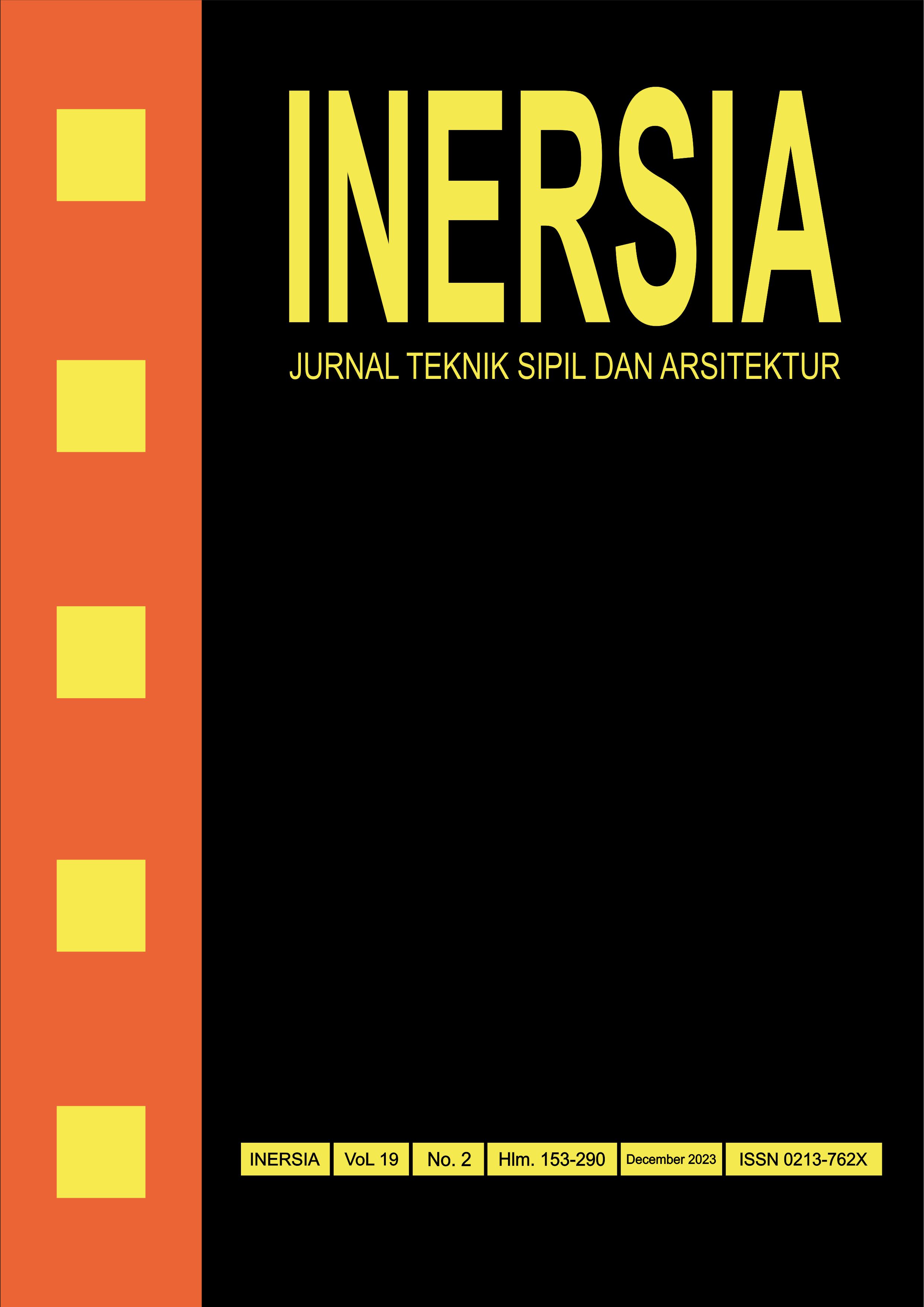Utilization of Plastic Bottle Waste as Material for Making Sustainable Cement-Less Aesthetic Paving Blocks
DOI:
https://doi.org/10.21831/inersia.v19i2.67250Keywords:
Paving Block, Cement Less, Aesthetic, Sustainable.Abstract
Plastic is a key ingredient in many products around the world, but its existence has caused serious problems due to the buildup of waste it produces. The construction industry is one of the sectors that can play a role in the utilization of plastic waste. One of them is in the production of paving blocks. This study aims to combine aesthetic aspects and environmental attractiveness in paving blocks without sustainable cement. An experimental method was chosen to develop an alternative to making sustainable paving blocks without the use of cement. Variations used to start from 20% PET: 80% aggregate, 25% PET: 75% aggregate, 30% PET: 70% aggregate, 35% PET: 65% aggregate, 40% PET: 60% aggregate. The aggregates used are sand and stone ash. Physical and mechanical qualities of paving blocks, such as compressive strength, absorption is carried out to determine the quality of paving blocks. The aesthetic aspect is also in focus by carrying out the concept of "glow in the dark". The results of physical and mechanical quality evaluation show that this paving block has adequate performance. The ratio of 20% PET and 80% sand reached paving category C with a compressive strength of 19.65 MPa, while the mixture with a ratio of 20% PET and 80% stone ash reached paving category B with a compressive strength of 24.20 MPa. This paving can be applied in the use of parks, pedestrian to parking lots. This suggests that the use of PET in the mixture can achieve sufficient strength in the paving industry. However, higher water absorption in mixtures with a higher percentage of PET needs to be taken into consideration. In addition, morphological and structural analysis reveals the presence of pores in the paving block that can affect the overall strength. These pores are caused by uneven melting of PET plastic during the manufacturing process. Based on the LCC evaluation, a higher economic value was obtained, but the resulting environmental impact made the product worthy of being one of the solutions to reduce plastic waste.
References
L. Warlani, "Pengelolaan Sampah Plastik Untuk Mitigasi Bencana Alam," Semin. Nas. FST Univ. Terbuka, pp. 89–110, 2019.
L. F. Amato-Lourení§o, L. dos Santos Galví£o, L. A. de Weger, P. S. Hiemstra, M. G. Vijver, and T. Mauad, "An emerging class of air pollutants: Potential effects of microplastics to respiratory human health?," Sci. Total Environ., vol. 749, p. 141676, 2020, doi: 10.1016/j.scitotenv.2020.141676.
Indonesiabaik.id, "Indonesia Darurat Sampah Plastik Di Laut," 2023. .
Alinea.id, "Upaya mengurangi sampah plastik di nusantara," 2023. .
O. Nkwachukwu, C. Chima, A. Ikenna, and L. Albert, "Focus on potential environmental issues on plastic world towards a sustainable plastic recycling in developing countries," Int. J. Ind. Chem., vol. 4, no. 1, p. 34, 2013, doi: 10.1186/2228-5547-4-34.
P. O. Awoyera and A. Adesina, "Plastic wastes to construction products: Status, limitations and future perspective," Case Stud. Constr. Mater., vol. 12, p. e00330, 2020, doi: 10.1016/j.cscm.2020.e00330.
R. Siddique, J. Khatib, and I. Kaur, "Use of recycled plastic in concrete: A review," Waste Manag., vol. 28, no. 10, pp. 1835–1852, 2008, doi: 10.1016/j.wasman.2007.09.011.
H. T. Mohan, K. Jayanarayanan, and K. M. Mini, "Recent trends in utilization of plastics waste composites as construction materials," Constr. Build. Mater., vol. 271, no. xxxx, p. 121520, 2021, doi: 10.1016/j.conbuildmat.2020.121520.
M. M. Ben Zair, F. M. Jakarni, R. Muniandy, S. Hassim, and A. H. Ansari, "A Brief Review: Application of Recycled Polyethylene Terephthalate as a Modifier for Asphalt Binder," Lect. Notes Civ. Eng., vol. 193, pp. 739–756, 2022, doi: 10.1007/978-3-030-87379-0_56.
R. Deraman, M. N. M. Nawi, M. N. Yasin, M. H. Ismail, and R. S. M. O. M. Ahmed, "Polyethylene Terephthalate Waste Utilisation for Production of Low Thermal Conductivity Cement Sand Bricks," J. Adv. Res. Fluid Mech. Therm. Sci., vol. 88, no. 3, pp. 117–136, 2021, doi: 10.37934/arfmts.88.3.117136.
S. Farooq and M. A. Kamal, "Recycling of Waste Polyethylene Terephthalate (PET) into Insulating Wall Panels for Building Industry," Civ. Eng. Archit., vol. 10, no. 5, pp. 2128–2133, 2022, doi: 10.13189/cea.2022.100531.
R. Kassab and P. Sadeghian, "Effects of material non-linearity on the structural performance of sandwich beams made of recycled PET foam core and PET fiber composite facings: Experimental and analytical studies," Structures, vol. 54, pp. 1259–1277, 2023, doi: 10.1016/j.istruc.2023.05.119.
A. I. N. Diana and D. Deshariyanto, "Effect of addition waste bottle and fly ash variation to compressive strength environmentally friendly paving block," J. Phys. Conf. Ser., vol. 1538, no. 1, 2020, doi: 10.1088/1742-6596/1538/1/012025.
I. Almeshal, B. A. Tayeh, R. Alyousef, H. Alabduljabbar, and A. M. Mohamed, "Eco-friendly concrete containing recycled plastic as partial replacement for sand," J. Mater. Res. Technol., vol. 9, no. 3, pp. 4631–4643, 2020, doi: 10.1016/j.jmrt.2020.02.090.
S. Agyeman, N. K. Obeng-Ahenkora, S. Assiamah, and G. Twumasi, "Exploiting recycled plastic waste as an alternative binder for paving blocks production," Case Stud. Constr. Mater., vol. 11, p. e00246, 2019, doi: 10.1016/j.cscm.2019.e00246.
Iswahyuni, H. Indri, Suharyanto, F. A. Uma, and N. H. Dewi, "Physical-mechanical properties of paving block from plastic shopping bags waste and sand," Key Eng. Mater., vol. 849 KEM, pp. 61–66, 2020, doi: 10.4028/www.scientific.net/KEM.849.61.
K. Tempa et al., "An experimental study and sustainability assessment of plastic waste as a binding material for producing economical cement-less paver blocks," Eng. Sci. Technol. an Int. J., vol. 26, no. xxxx, 2022, doi: 10.1016/j.jestch.2021.05.012.
P. Li et al., "Luminous and bonding performance of self-luminescent cementitious coatings based on white cement and geopolymer," Constr. Build. Mater., vol. 362, no. November 2022, p. 129814, 2023, doi: 10.1016/j.conbuildmat.2022.129814.
W. Wang et al., "Self-luminescent cement-based composite materials: properties and mechanisms," Constr. Build. Mater., vol. 269, p. 121267, 2021, doi: 10.1016/j.conbuildmat.2020.121267.
Q. Han, P. Zhang, J. Wu, Y. Jing, D. Zhang, and T. Zhang, "Comprehensive review of the properties of fly ash-based geopolymer with additive of nano-SiO2," Nanotechnol. Rev., vol. 11, no. 1, pp. 1478–1498, 2022, doi: 10.1515/ntrev-2022-0092.
A. Zhang, W. Yang, Y. Ge, Y. Du, and P. Liu, "Effects of nano-SiO2 and nano-Al2O3 on mechanical and durability properties of cement-based materials: A comparative study," J. Build. Eng., vol. 34, p. 101936, 2021, doi: 10.1016/j.jobe.2020.101936.
J. Luo, X. Shi, Q. Wang, J. Dai, X. Deng, and Y. Xue, "Study on Improving Measures of Mechanical Properties of Geopolymer Materials and Its Effect on CO2 Emission," Polymers (Basel)., vol. 15, no. 7, 2023, doi: 10.3390/polym15071699.
G. Cibilakshmi and J. Jegan, "A DOE approach to optimize the strength properties of concrete incorporated with different ratios of PVA fibre and nano-Fe2O3," Adv. Compos. Lett., vol. 29, pp. 1–16, 2020, doi: 10.1177/2633366X20913882.
Y. WANG and J. GAO, "Effect of MgO and Al2O3 on High-temperature Stability Performance of High-alumina Cement," Mater. Sci., vol. XX, no. X, pp. 1–8, 2023, doi: 10.5755/j02.ms.33912.
J. Zhang, X. Jia, and Q. He, "Mechanical, thermal, and friction properties of addition-type fluororubber co-filled with Al2O3 particles at high temperature," Polym. Test., vol. 96, no. November 2020, p. 107131, 2021, doi: 10.1016/j.polymertesting.2021.107131.
E. Bachtiar et al., "Examining polyethylene terephthalate (Pet) as artificial coarse aggregates in concrete," Civ. Eng. J., vol. 6, no. 12, pp. 2416–2424, 2020, doi: 10.28991/cej-2020-03091626.
B. Z. Nurjaman, R. Roestaman, and E. Walujodjati, "Pengaruh Penggunaan Agregat Abu Batu Sebagai Pengganti Agregat Halus Alami Terhadap Sifat-Sifat Beton," J. Konstr., vol. 19, no. 1, pp. 31–42, 2021, doi: 10.33364/konstruksi/v.19-1.890.
E. Rahmani, M. Dehestani, M. H. A. Beygi, H. Allahyari, and I. M. Nikbin, "On the mechanical properties of concrete containing waste PET particles," Constr. Build. Mater., vol. 47, pp. 1302–1308, 2013, doi: 10.1016/j.conbuildmat.2013.06.041.
P. M. Correa, D. Guimarí£es, R. M. C. Santana, and í‚. G. Graeff, "Potential use of PET and PP as partial replacement of sand in structural concrete," Rev. Mater., vol. 26, no. 3, 2021, doi: 10.1590/S1517-707620210003.13009.
Downloads
Published
How to Cite
Issue
Section
License
Authors who publish with INERSIA journal agree to the following terms:
- Authors retain copyright and grant the INERSIA journal right of first publication with the work simultaneously licensed under Creative Commons Attribution License (CC BY 4.0) that allows others to share the work with an acknowledgment of the work's authorship and initial publication in this journal.
- Authors can enter into separate, additional contractual arrangements for the non-exclusive distribution of the published version of the work (e.g., post it to an institutional repository or edit it in a book), with an acknowledgment of its initial publication in this journal.
- Authors are permitted and encouraged to post their work online (e.g., in institutional repositories or on their website) before and during the submission process, as it can lead to productive exchanges, as well as earlier and greater citation of published work.

INERSIA by https://journal.uny.ac.id/index.php/inersia was distributed under a Creative Commons Attribution 4.0 International License











